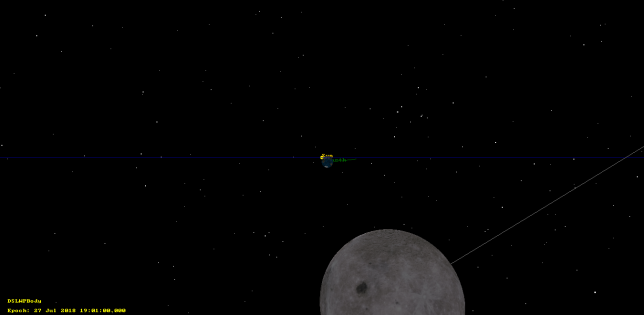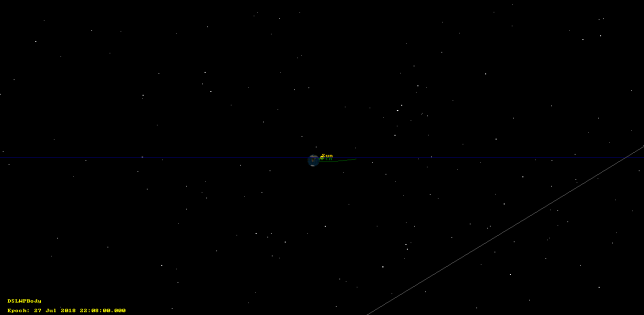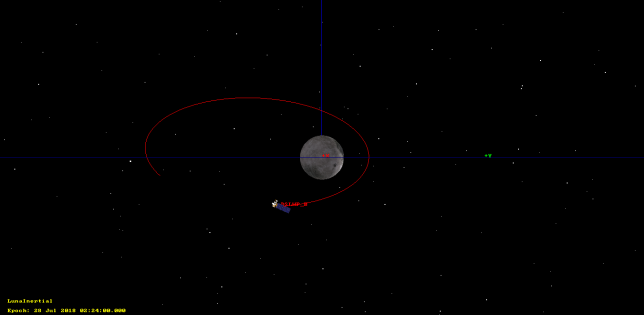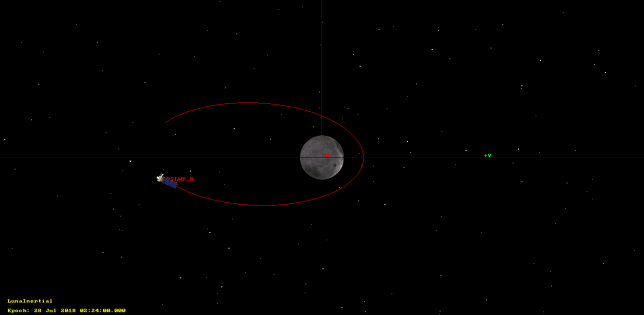As you may well know, last Friday 27th July there was a total lunar eclipse. This is an interesting event for lunar-orbiting spacecraft such as DSLWP-B. In fact, depending on the spacecraft’s orbit, it may also pass through the Earth’s umbra or penumbra. Here I look at the trajectory taken by DSLWP-B during the eclipse.
I will use the 20180727 tracking file published by Wei Mingchuan BG2BHC in dslwp_dev as the reference for DSLWP-B’s orbit. The orbit will be propagated using GMAT.
Interestingly, Wei had informed on Twitter that a periapsis raise manoeuvre was to be performed in preparation for the eclipse. As far as I know, this is the first manoeuvre performed by DSLWP-B since lunar orbit injection on May 25.
Hi, no vhf/uhf this weekend. Perigee raised on Friday for the comming lunar eclipse next Saturday.
— BG2BHC (@bg2bhc) July 22, 2018
I will look at the details of this manouvre later.
I have used the GMAT script lunar_eclipse.script to analyse and plot the eclipse. The results of the eclipse can be seen below. We can see that DSLWP-B only passes Earth’s penumbra. The eclipse has a duration of 2 hours and 51 minutes.
Spacecraft: DSLWP_B Start Time (UTC) Stop Time (UTC) Duration (s) Occ Body Type Event Number Total Duration (s) 27 Jul 2018 18:49:53.734 27 Jul 2018 21:40:31.226 10237.491566 Earth Penumbra 1 10237.491566 Number of individual events : 1 Number of total events : 1 Maximum duration (s) : 10237.491566 Maximum duration at the 1st eclipse.
The fact that DSLWP-B only crossed Earth’s penumbra had already being confirmed by Wei:
Not across the umbra but penumbra
— BG2BHC (@bg2bhc) July 28, 2018
The images below show the beginning and end of the partial eclipse as seen by DSLWP-B. It is interesting to open the script with GMAT and view the full animation.


Also note that during the beginning of the eclipse, DSLWP-B was “behind” the Moon. I don’t know if DSLWP-B has taken any pictures during the eclipse, but this was a very special moment for taking pictures of the Moon, Earth and Sun.
Now we turn to the study of the periapsis raise manouevre. No more information than the tweet shown above has been disclosed so far. The only information we have are the tracking files. We will use the 20180727 file, which contains data after the manoueuvre and the 20180714 file, which contains data before the manouevre.
Both tracking files have been propagated to a common time and its orbital state has been compared. The 20180727 file gives the following data:
Time System Gregorian Modified Julian ---------------------------------------------------------------------- UTC Epoch: 28 Jul 2018 02:24:00.000 28327.6000000000 Keplerian State -------------------------------- SMA = 8945.1472897569 km ECC = 0.5907085382689 INC = 36.655699761119 deg RAAN = 267.27990893732 deg AOP = 172.41017102530 deg TA = 125.76910376520 deg MA = 55.614846311349 deg EA = 89.458440623567 deg Periapsis Altitude = 1922.9724096248 km Apoapsis Radius = 14229.122169889 km
In comparison, the 20180714 file gives:
Time System Gregorian Modified Julian ---------------------------------------------------------------------- UTC Epoch: 28 Jul 2018 02:24:00.000 28327.6000000000 Keplerian State -------------------------------- SMA = 8757.6302171240 km ECC = 0.6259094125005 INC = 36.896428370649 deg RAAN = 267.30527700679 deg AOP = 171.92522232470 deg TA = 174.17577133386 deg MA = 160.37068303845 deg EA = 167.89256646016 deg Periapsis Altitude = 1537.9470330272 km Apoapsis Radius = 14239.113401221 km
We see that the periapsis altitude has been raised 385km by the manouvre. The apoapsis has only changed by 10km, and the inclination, right ascension of ascending node and argument of perigee have changed very little. Thus we conclude that the only effect of the manoeuvre has been to raise the periapsis by 385km.
The reason for performing the manouvre has not been disclosed. However, it is interesting to note that if the manouvre had not been performed, then DSLWP-B would have entered Earth’s umbra. Maybe the reason for the manouvre was to try to miss the eclipse (as it is not so good for the spacecraft, for energetic and thermal reasons).
Indeed, we can use the GMAT script lunar_eclipse2.script to compute the eclipse trajectory using data propagated from the 20180714 file. The eclipse information is as follows:
Spacecraft: DSLWP_B Start Time (UTC) Stop Time (UTC) Duration (s) Occ Body Type Event Number Total Duration (s) 27 Jul 2018 17:01:40.288 27 Jul 2018 18:29:43.219 5282.9311941 Earth Penumbra 1 5282.9311941 27 Jul 2018 20:23:21.008 27 Jul 2018 23:29:36.137 11175.128963 Earth Penumbra 2 20518.101431 27 Jul 2018 23:29:36.137 28 Jul 2018 00:12:42.257 2586.1202368 Earth Umbra 2 20518.101431 28 Jul 2018 00:12:42.257 28 Jul 2018 02:05:19.110 6756.8522319 Earth Penumbra 2 20518.101431 Number of individual events : 4 Number of total events : 2 Maximum duration (s) : 20518.101431 Maximum duration at the 2nd eclipse.
We see that DSLWP-B would have entered eclipse twice, and spent 43 minutes in the umbra. The total time spent in eclipse would have been 7 hours and 10 minutes. Therefore, raising the periapsis by 385km has made a huge difference.
The two images below show a comparison of the orbit including the periapsis raise manouevre and the orbit disregarding the manouevre.


So far this is more or less all I can write about this interesting event. It would be great to have more information from the DSLWP team regarding the periapsis raise manouevre and Doppler measurements taken during the manouevre and the eclipse.
Very interesting! Thanks for putting all that info together.
I have tried to run those 2 scripts in GMAT R2017a, but get errors in lines 63, 65, 141, & 173 all similar to:
“**** ERROR **** Interpreter Exception: The field name “GravityField.Luna.StmLimit” on object “LunaProp_ForceModel” is not permitted in line: ” 63:
… by chance is R2018a required for these scripts?
(I would check that myself, but get library errors when trying to run GMAT R2018a)
Thanks!
My mistake! The default download for GMAT is RedHat – I needed the Ubuntu version. Both scripts run perfectly in R2018a now. I hope my foolishness is helpful to someone else who has an older version of GMAT, or who downloads GMAT for the wrong operating system!